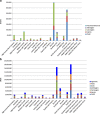The Global Burden of Occupational Disease
- PMID: 28733964
- PMCID: PMC5591369
- DOI: 10.1007/s40572-017-0151-2
The Global Burden of Occupational Disease
Abstract
Purpose of review: Burden of occupational disease estimation contributes to understanding of both magnitude and relative importance of different occupational hazards and provides essential information for targeting risk reduction. This review summarises recent key findings and discusses their impact on occupational regulation and practice.
Recent findings: New methods have been developed to estimate burden of occupational disease that take account of the latency of many chronic diseases and allow for exposure trends and workforce turnover. Results from these studies have shown in several countries and globally that, in spite of improvements in workplace technology, practices and exposures over the last decades, occupational hazards remain an important cause of ill health and mortality worldwide. Major data gaps have been identified particularly regarding exposure information. Reliable data on employment and disease are also lacking especially in developing countries. Burden of occupational disease estimates form an important part of decision-making processes.
Keywords: Burden estimation; Cancer; Exposure assessment; Impact; Occupation; Respiratory disease.
Conflict of interest statement
Conflict of Interest
Lesley Rushton declares that she has no conflicts of interest.
Human and Animal Rights and Informed Consent
This article does not contain any studies with human and animal subjects performed by the author.
Figures


References
-
- Landrigan PL, Schechter CB, Lipton JM, Fahs MC, Schwartz J. Environmental pollutants and disease in American children: estimates of morbidity, mortality and costs for lead poisoning, asthma, cancer, and developmental disabilities. Environ Health Perspect. 2002;110:721–728. doi: 10.1289/ehp.02110721. - DOI - PMC - PubMed
Publication types
MeSH terms
LinkOut - more resources
Full Text Sources
Other Literature Sources
Medical
Research Materials

